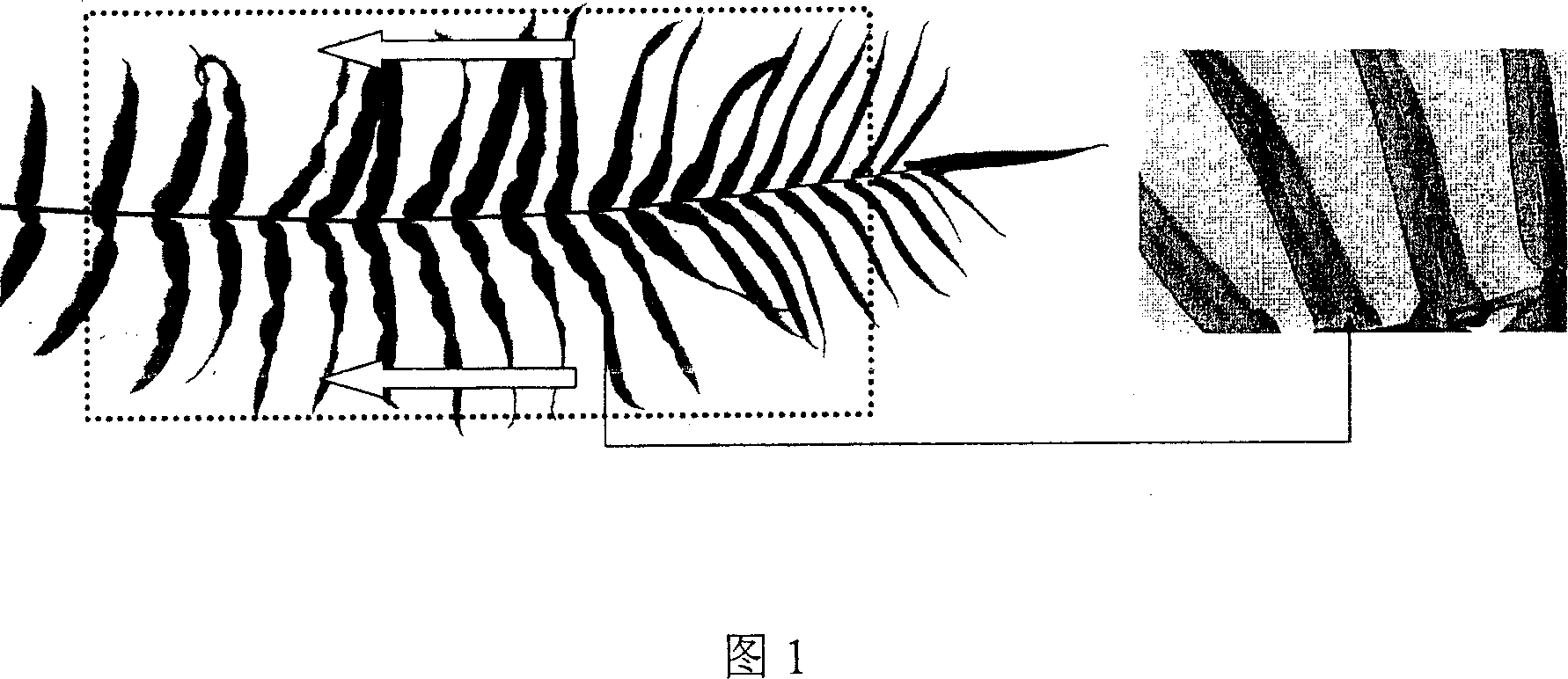Method for quickly tissue culture reproducing using ciliate desert-grass spore
A technology of centipede grass and grass spores is applied in the field of tissue culture and seedling propagation by using centipede grass spores, and can solve the problems of limited number of underground stems, death of centipede grass and the like
- Summary
- Abstract
- Description
- Claims
- Application Information
AI Technical Summary
Problems solved by technology
Method used
Image
Examples
Embodiment 1
[0020] From the mature sporophyte of Centipede grass (Chenzhou, Hunan Province), the sporangia were brown, and the spores from the 6th to 41st pinnae at the top of the leaf were taken from top to bottom. A schematic diagram of the sampling location and photos of spores are shown in Figure 1.
[0021] Mature spores were sterilized with 70% ethanol for 1.5 min followed by 0.1% HgCl 2 The solution was sterilized for 3 minutes and rinsed 6 times with sterile water, and the spore microorganism contamination rate was less than 10%. Seed spores to 1 / 2 Knop + 0.5% CaCO 3 +1% sucrose medium, placed in a light incubator with a temperature of 25°C and a light intensity of 1000 lux, and the light time is 16 hours a day. After 60 days of culture, the spores germinate into prothallus and grow into the desired Aseptic sporophyte plants, the proportion of prothallus producing sporophyte plants can reach 56%. The spore plant production rate of other formula mediums is not as good as this fo...
Embodiment 2
[0032] The operation is the same as that of Example 1, and the medium for inducing callus in step 2 is MS+KT 4.6 μmol / L+NAA 0.1 μmol / L+0.7% agar+3% sucrose. The rooting medium used in step 4 was 1 / 2 MS+KT 0.5 μmol / L+NAA 2.7 μmol / L+0.7% agar+1% sucrose. 10 spores were inoculated, and after one subculture, 79 sporophyte plants were obtained, with an average of 7.9 sporophyte plants per spore.
Embodiment 3
[0034]The tissue culture seedlings bred in Example 1 were taken. After more than 200 days of storage, these seedlings still maintained vigorous vigor. Through a series of cultivation such as transfer and proliferation, the seedlings can be successfully transplanted into the field and survive after training. After being transplanted into the soil containing 507mg / kg of arsenic and cultivated for 100 days, the content of arsenic in the shoots can be as high as 3800mg / kg. The variation range of arsenic content in Centipede grass plants in the spore producing area is 3000-5000 mg / kg. This confirmed that the arsenic-accumulating ability of centipede grass was not degraded during long-term storage. This means that when the centipede grass is used to remediate large-area arsenic-contaminated soil, the present invention can be used to provide enough centipede grass seedling sources. In addition, the method of the present invention is not limited by natural conditions, regional diffe...
PUM
 Login to View More
Login to View More Abstract
Description
Claims
Application Information
 Login to View More
Login to View More - R&D
- Intellectual Property
- Life Sciences
- Materials
- Tech Scout
- Unparalleled Data Quality
- Higher Quality Content
- 60% Fewer Hallucinations
Browse by: Latest US Patents, China's latest patents, Technical Efficacy Thesaurus, Application Domain, Technology Topic, Popular Technical Reports.
© 2025 PatSnap. All rights reserved.Legal|Privacy policy|Modern Slavery Act Transparency Statement|Sitemap|About US| Contact US: help@patsnap.com

